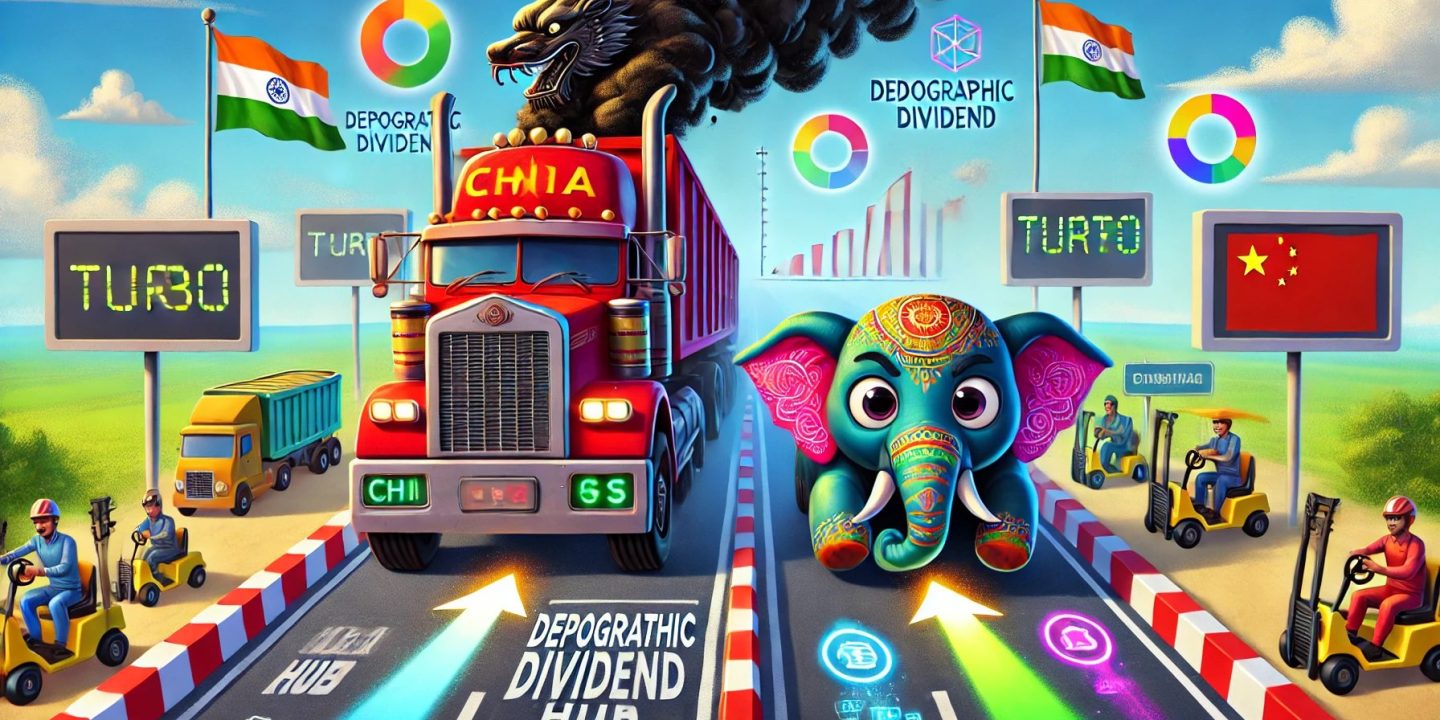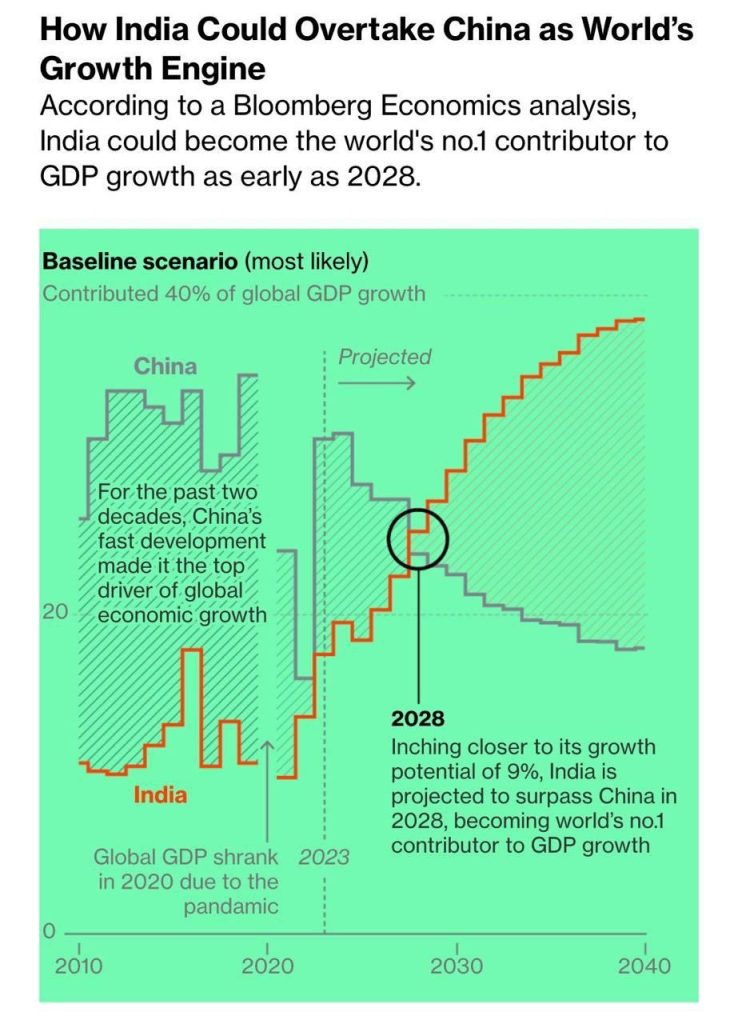
“India’s Economic Ascent: How India is Poised to Surpass China as the World’s Leading Growth Engine by 2028”
Farhad Reyazat – PhD in Risk Management Bio
Citation: Reyazat, F. (2024b, September 5). India’s Economic Ascent: How India is Poised to Surpass China as the World’s Leading Growth Engine by 2028. https://www.reyazat.com/2024/09/05/indias-economic-ascent-how-india-is-poised-to-surpass-china-as-the-worlds-leading-growth-engine-by-2028/
According to an analysis by Bloomberg Economics, India is poised to surpass China as the world’s primary contributor to global GDP growth by 2028. This forecast is based on a baseline scenario where India’s rapidly expanding economy is expected to outperform China’s long-standing role as the top driver of global economic expansion.

Source: Bloomberg Economics analysis on global GDP growth projections and IMF statistics.
Critical Insights from Bloomberg Economics:
1. China’s Historical Dominance: For the past two decades, China has been the most significant engine of global GDP growth. Thanks to aggressive economic reforms and a surge in manufacturing, China’s rapid development made it the leading contributor to global economic expansion. Its role in shaping international trade and investment has been unparalleled since the early 2000s.
2. India’s Economic Ascent: By 2028, India is predicted to overtake China, driven by its projected growth potential of 9%. With a burgeoning middle class, an increasingly young workforce, and expanding sectors like technology and services, India is on the cusp of becoming the world’s top economic driver.
3. The Pandemic’s Impact: The COVID-19 pandemic caused a significant contraction in global GDP in 2020, disrupting the economic trajectories of several major economies, including China and India. However, both nations bounced back with stimulus measures, though China’s recovery has since shown signs of slowing down while India’s momentum continues to build.
4. Projected Shift Post-2023: The Bloomberg analysis indicates that India’s GDP growth will accelerate significantly from 2023 onward, eventually overtaking China by 2028. Once this shift occurs, India is expected to become the main contributor to global GDP growth for the foreseeable future.
Supporting Statistics and Evidence
– India’s Growing GDP: India has consistently reported robust GDP growth over the past decade, frequently exceeding 6% annually. The International Monetary Fund (IMF) projects India’s growth rate at 6.1% in 2023 and 6.8% in 2024, driven by high domestic consumption, a tech-forward services sector, and increased foreign direct investment (FDI). By contrast, China’s growth is projected to slow to around 5% during the same period as it grapples with an aging population and slowing industrial growth.
– Demographic Dividend: India’s demographic advantage is one of its most vital assets. With a median age of around 28 years, India enjoys a younger, more dynamic workforce compared to China, where the median age is around 39. As China’s workforce begins to shrink due to its aging population, India’s large and youthful labor force is expected to fuel economic growth for decades.
– Manufacturing and Services Growth: The Indian government’s “Make in India” initiative has been pivotal in boosting the country’s manufacturing output. Combined with its world-renowned services sector—particularly in information technology and business process outsourcing—India is building a diverse and resilient economy. Its tech sector, in particular, is expected to increase, contributing heavily to its GDP.
– Infrastructure Development and Foreign Investment: India has also made significant strides in improving infrastructure and making it easier to do business—substantial investments in roads, railways, ports, and digital infrastructure support rapid urbanization and industrial growth. In 2021 alone, India attracted $83.57 billion in foreign direct investment, making it one of the most sought-after markets for global investors.
– Global Recognition: Major global institutions and investors recognize India’s potential. For instance, Morgan Stanley recently upgraded its outlook on India, stating that it is in a once-in-a-generation growth phase driven by rapid urbanization and strong consumption patterns.
The Bigger Picture
India’s potential rise to the top of global GDP contributors signals a significant shift in global economic dynamics. For decades, China has been synonymous with international growth, but its aging population, slower economic reforms, and a decelerating industrial sector contribute to a gradual decline in its dominance.
Meanwhile, India’s demographic dividend, strong consumption patterns, a growing middle class, and a tech-forward services sector place it in a prime position to lead global growth in the coming decade. As India continues to invest in its infrastructure, embrace digital transformation, and implement business-friendly reforms, it is well on its way to becoming the world’s next economic powerhouse.
Conclusion
The transition of economic leadership from China to India represents more than just a shift in numbers; it reflects broader changes in global economic power. As India gears up to become the world’s growth engine by 2028, the country’s continued focus on innovation, infrastructure, and inclusive growth will be pivotal to maintaining its economic momentum.






No Comments